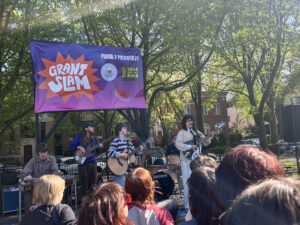Ever wished you could see Taylor Swift battle a jar of pickles? What about a toaster oven battling Winnie the Pooh? Or maybe even an overly caffeinated ghost of Christmas past versus a 1950s housewife? That reality may be closer than you might think with “Jazz vs Waffles,” a new online party game created by a group of graduate students at DePaul University and Columbia College Chicago.
Created in the style of traditional role playing games and fused with the capabilities of AI-generated language models, the game allows users to enter a character and opponent of their choosing to duke it out virtually. Users are able to select plays for their character in virtual battles as AI generates results and narrates the experience.
Kim Galovich, a graduate student at Columbia College who is earning her MFA in creative writing, and her boyfriend Tyler Sanders, a game design MFA student at DePaul University, are two of the three brains behind the project, which first began to take shape last August.
“Originally we were thinking that this is just a student project experiment that we’re doing — make the prototype of it then move onto the next project,” Sanders said. “But our friends just kept sending us so many screenshots of ridiculous things that they were making with it and people kept wanting to play it.”
The group of creators have spent hundreds of hours of work developing and tweaking the game and integrating the AI model. “So much of the time spent on it has just been figuring out how to make the AI, the large language model, do what we need it to do,” Galovich said.
AI has been a part of video games for many years and has shown up in elements such as “if-then” scenarios that anticipate players’ decisions. For the creators of “Jazz vs Waffles,” AI has offered opportunities for custom gameplay that wouldn’t be possible without the new language model.
“We’re mainly thinking of it, in terms of this game, as an opportunity because this game couldn’t exist without [it]. Five years ago, you couldn’t make this game,” Sanders said. “We’re just trying to lean into the new affordances provided by this technology.”
“Jazz vs Waffles” opens with allowing players to type in any person, object or thing they want to play as a character. From there, users can select their own opponent in the game, or roll the dice and allow the AI model to select the opposition before leading into the good-spirited battle between subjects. The battle continues between subjects as text dialog representing each opponent is scribbled across the screen and action prompts for attacks are offered. The game is generally a good-spirited battle between the chosen subjects, and visually takes reference from the 2-bit aesthetic of late 20th century games.
“We’ll make sure to use any catchphrases that [character] is known for, or if they are known for talking in a thick accent, it will capture that or any nuances like that, and that adds a lot of humor to the game,” Sanders said of the game’s generated characters. “We’re thinking of it very much in the lens of improv comedy, where the cast asks for a suggestion from the audience and then uses that suggestion.”
Matthew Payne, associate professor of film, television, and theatre at the University of Notre Dame, has extensively researched and written about video gaming and its culture. The integration of AI into video gaming, such as what “Jazz vs Waffles” has done, can allow users more opportunities in gameplay, he said.
“On the one hand, it promises to give game-makers more ways of crafting and expanding their imaginary worlds at a fraction of the production costs,” Payne said. The result, he said, can “allow players to have more diverse and interesting play experiences.”
As with most emerging technologies, there are legitimate concerns about what AI technology might do when implemented into creative work. “Embedding AI tools into games introduces unknowns that could destabilize or upend the gameplay experience since the designers are ceding content creation to these new tools,” Payne added.
The game has only been available to play since this spring and is still in its beta phase. However, it’s already amassed around 700 users. In going forward with the “Jazz vs Waffles,” Galovich and Sanders hope to get the game to a wider audience and showcase the positive ways that AI can be used in creative fields.
“But if I’m honest with myself my actual biggest hope is that a lot of people play it and send me their screenshots of the silly things they made,” she added with a chuckle.







Be First to Comment